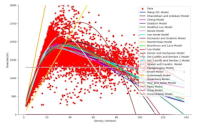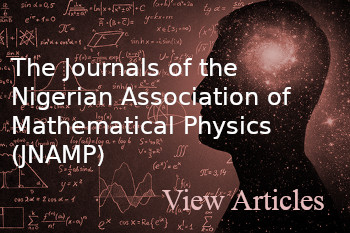PREDICTIVE ACCURACY AND TRANSFERABILITY OF A NEWLY PROPOSED TRAFFIC FLOW MODEL AND SELECTED MODELS
DOI:
https://doi.org/10.60787/tnamp-v20-351Keywords:
Fundamental diagram, Traffic flow, Cross-validation, Flow-Density model, Mathematical modelAbstract
Over the past eight decades, functional forms of an empirical macroscopic fundamental diagram have been continually proposed yet the predictive power of most models at mid and high densities continuous to be questionable to the traffic flow research community. K-fold cross-validation was used to assess and compare the predictive performance of some macroscopic equilibrium fundamental diagram with a newly proposed model. The results reveal that the newly proposed model perform better than the other models in predicting traffic states, particularly, in mid and high densities. This shows that the proposed model could be useful for extrapolation of traffic states at mid and high densities. Furthermore, the proposed model shows consistently good performance across various roads despite its few parameters. This proves that the proposed model has high flexibility that enables it to adapt to most of the trends of traffic data. It is therefore concluded that a single-regime model with few parameters is capable of accurately describing empirical fundamental diagram.
Downloads
References
D. M. Bramich, M. Menendez, and L. Ambuhl, “Fitting Empirical Fundamental Diagrams of Road Traffic: A Comprehensive Review and Comparison of Models Using an Extensive Data Set,” IEEE Trans. Intell. Transp. Syst., vol. 23, no. 9, pp. 14104–14127, 2022a, doi: 10.1109/TITS.2022.3142255.
Q. Cheng, Z. Liu, Y. Lin, and X. (Simon) Zhou, “An s-shaped three-parameter (S3) traffic stream model with consistent car following relationship,” Transp. Res. Part B Methodol., vol. 153, pp. 246–271, Nov. 2021, doi: 10.1016/j.trb.2021.09.004.
G. Dahiya, Y. Asakura, and W. Nakanishi, “Analysis of the single-regime speed-density fundamental relationships for varying spatiotemporal resolution using Zen Traffic Data,” Asian Transp. Stud., vol. 8, p. 100066, 2022, doi: 10.1016/j.eastsj.2022.100066.
H. K. Gaddam and K. R. Rao, “Speed–density functional relationship for heterogeneous traffic data: a statistical and theoretical investigation,” J. Mod. Transp., vol. 27, no. 1, pp. 61–74, Mar. 2019, doi: 10.1007/s40534-018-0177-7.
M. Y. Mafuyai, D. D. Bakwa, and Y. Y. Jabil, “A Single-Regime Fundamental Diagram of Vehicular Traffic with Excellent Performance at All Traffic States.” 2024. doi: 10.2139/ssrn.4777787.
M. J. Cassidy, “Bivariate relations in nearly stationary highway traffic,” Transp. Res. Part B Methodol., vol. 32, no. 1, pp. 49–59, 1998, doi: 10.1016/S0191-2615(97)00012-X.
J. M. Del Castillo and F. G. Benitez, “On the functional form of the speed-density relationship—I: General theory,” Transp. Res. Part B Methodol., vol. 29B, no. 5, pp. 373–389, Oct. 1995, doi: 10.1016/0191-2615(95)00008-2.
J. S. Drake, J. L. Schofer, and A. D. May, “A Statistieal Analysis of Speed Density Hypotheses,” Veh. Traffic Sci., vol. 154, pp. 112–117, 1967.
L. C. Edie, “Car-Following and Steady-State Theory for Noncongested Traffic,” Oper. Res., vol. 9, no. 1, pp. 66–76, 1961.
H. M. Zhang, “Amathematical theory of traffic hysteresis,” Transp. Res. Part B, vol. 33, pp. 1–23, 1999.
H. Wang, J. Li, Q.-Y. Chen, and D. Ni, “Logistic modeling of the equilibrium speed–density relationship,” Transp. Res. Part Policy Pract., vol. 45, no. 6, pp. 554–566, Jul. 2011, doi: 10.1016/j.tra.2011.03.010.
D. M. Bramich, M. Menendez, and L. Ambuhl, “Fitfun: A modelling framework for successfully capturing the function form and noise of observed traffic flow-density-speed relationships,” Transp. Res. Part C, vol. 151, p. 104068, 2023, doi: 10.1016/j.trc.2023.104068.
A. Romanowska and K. Jamroz, “Comparison of Traffic Flow Models with Real Traffic Data Based on a Quantitative Assessment,” Appl. Sci., vol. 11, no. 21, p. 9914, Oct. 2021, doi: 10.3390/app11219914.
D. Ni, J. D. Leonard, C. Jia, and J. Wang, “Vehicle Longitudinal Control and Traffic Stream Modeling,” Transp. Sci., vol. 50, no. 3, pp. 1016–1031, Aug. 2016, doi: 10.1287/trsc.2015.0614.
R. Kucharski and A. Drabicki, “Estimating Macroscopic Volume Delay Functions with the Traffic Density Derived from Measured Speeds and Flows,” J. Adv. Transp., vol. 2017, pp. 1–10, Feb. 2017, doi: 10.1155/2017/4629792.
Y. Wang et al., “Macroscopic traffic flow modelling of large-scale freeway networks with field data verification: State-of-the-art review, benchmarking framework, and case studies using METANET,” Transp. Res. Part C, vol. 145, Oct. 2022, doi: https://doi.org/10.1016/j.trc.2022.103904.
Greenshields, B.D., “A study of traffic capacity,” Proc Highw. Res Board, vol. 14, pp. 448–477, 1935.
D. R. Drew, Traffic flow theory and control. New York: McGraw-Hill, 1968.
L. A. Pipes, “Car following models and the fundamental diagram of road traffic,” Transp. Res., vol. 1, no. 1, pp. 21–29, May 1967, doi: 10.1016/0041-1647(67)90092-5.
A. D. May and M. Keller, “Non-Integer Car-Following Models,” Highw Res Rec, vol. 199, pp. 19–32, 1967.
R. Jayakrishnan, W. K. Tsai, and A. Chen, “A dynamic traffic assignment model with traffic-flow relationships,” Transp. Res. Part C Emerg. Technol., vol. 3, no. 1, pp. 51–72, Feb. 1995, doi: 10.1016/0968-090X(94)00015-W.
H. Greenberg, “An Analysis of Traffic Flow,” Oper. Res., vol. 7, no. 1, pp. 79–85, Feb. 1959.
R. T. Underwood, “Speed, volume and density relationships,” in Quality and Theory of Traffic flow, Yale University, New Haven, Connecticut: Bureau of highway Traffic, 1961, pp. 141–188.
M. Papageorgiou, J.-M. Blosseville, and H. Hadj-Salem, “MACROSCOPIC MODELLING OF TRAFFIC FLOW ON THE BOULEVARD PfiRIPHgRIQUE IN PARIS,” Transp. Res. Part B, vol. 23B, no. 1, pp. 29–47, 1989.
Franklin, R.E., “The structure of a traffic shock wave,” Civ. Eng Public Works Rev, vol. 56, no. 1186–1188, 1961.
G. F. Newell, “Nonlinear Effects in the Dynamics of Car Following,” Oper. Res., vol. 9, no. 2, pp. 209–229, Apr. 1961, doi: 10.1287/opre.9.2.209.
Kerner, B.S. and Konhauser, P., “Structure and parameters of cluster in traffic flow,” Phys. Rev. E, vol. 50, no. 1, pp. 54–86, Jul. 1994.
H. Y. Lee, H. W. Lee, and D. Kim, “Origin of synchronized raffic flow on highways and its dynamic phase transitions.,” Phys Rev Lett, vol. 81, no. 5, pp. 1130–1133, 1998, doi: 10.1103/physRevLstt.81.1130.
A. E. Boardman and L. B. Lave, “Highway congestion and congestion tolls,” J Urban Econ, vol. 4, pp. 340–359, 1977, doi: 10.1016/0094-1190(77)90016-X.
van Aerde, M., “A single regime speed-flow-density for freeways and arterials,” pp. 1–19, 1995.
Bando, M., Hasebe, K., Nakayama, A., Shibata, A., and Sugiyama, Y, “Dynamical model of traffic congestion and numerical simulation,” Phys. Rev. E, vol. 51, no. 2, Feb. 1995.
Ghandehari, M. and Ardekani, S., “A modified greeberg speed-flow traffic model,” Dept Math Univ Tex. Arlingt. Arlinton TX USA Tech Rep, vol. 357, 2008.
MacNicholas, M.J., “A simple pragmatic representation of traffic flow,” Tansp. Res. Circular, pp. 161–177, 2008.
D. C. Gazis, R. Herman, and R. B. Potts, “Car-Following Theory of Steady-State Traffic Flow,” Oper. Res., vol. 7, no. 4, pp. 499–505, Aug. 1959.
X. Qu, S. Wang, and J. Zhang, “On the fundamental diagram for freeway traffic: A novel calibration approach for single-regime models,” Transp. Res. Part B Methodol., vol. 73, pp. 91–102, Mar. 2015, doi: 10.1016/j.trb.2015.01.001.
F. L. Hall, “Traffic Stream Characteristics,” in Traffic Flow Theory: A State-of-the-art Report, 2nd ed., Tranportation Research Board’s Committee A3A11, 2001, p. 2.1-2.34.
N. Maiti and B. R. Chilukuri, “Empirical Investigation of Fundamental Diagrams in Mixed Traffic,” IEEE Access, vol. 11, pp. 13293–13308, 2023, doi: 10.1109/ACCESS.2023.3242971.
A. C. Dick, “Speed/flow relatioships within an urban area,” Traffic Eng Control, vol. 8, pp. 393–396, 1966.
P. K. Munjal, Y. S. Hsu, and R. L. Lawrence, “Analysis and validation of lane-drop effects on multi-lane freeways,” Transp. Res., vol. 5, pp. 257–266, 1971, doi: 10.1016/0041-1647(71)90037-2.
S. A. Smulder, Control of Freeway Traffic Flow. Amsterdam, The Netherlands: Stichting Mathematisch Centrum, 1989.
A. D. May, Traffic Flow Fundamentals. Prentice Hal, 1990.
C. F. Daganzo, “Fundamentals of Transportation and Traffic Operations,” Emerald: Bingley, UK., 1997.
N. Wu, “A new approach for modeling of Fundamental Diagrams,” 2002.
D. M. Bramich, M. Menendez, and L. Ambühl, “Road traffic time-series measurements of flow and occupancy from 10,150 loop detectors in 25 cities,” Harvard Dataverse, 2022b. [Online]. Available: https://dataverse.harvard.edu

Downloads
Published
Issue
Section
License
Copyright (c) 2024 The Transactions of the Nigerian Association of Mathematical Physics

This work is licensed under a Creative Commons Attribution-NonCommercial 4.0 International License.




